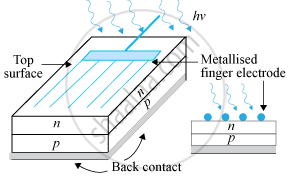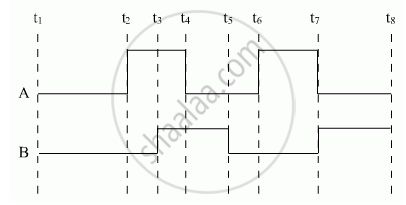Advertisements
Advertisements
Question
Answer the following question.
Explain the three processes involved in solar cell working.
Solution

The generation of emf by a solar cell, when light falls on, it is due to the following three basic processes: generation, separation and collection
- generation of e-h pairs due to light (with hν > Eg) close to the junction
- separation of electrons and holes due to electric field of the depletion region. Electrons are swept to n-side and holes to p-side
- the electrons reaching the n-side are collected by the front contact and holes reaching the p-side are collected by the back contact. Thus the p-side becomes positive and the n-side becomes negative giving rise to photo-voltage.
APPEARS IN
RELATED QUESTIONS
Colour of light emitted by LED depends upon__________________ .
- its forward bias
- its reverse bias
- the band gap of the material of semiconductor
- its size
A p-n photodiode is fabricated from a semiconductor with band gap of 2.8 eV. Can it detect a wavelength of 6000 nm?
The width of depletion region of p-n junction diode is _______.
(A) 0.5 nm to 1 nm
(B) 5 nm to 10 nm
(C) 50 nm to 500 nm
(D) 500 nm to 1000 nm
Show the output waveforms (Y) for the following inputs A and B of (i) OR gate (ii) NAND gate ?

Describe briefly, with the help of a diagram, the role of the two important processes involved in the formation of a p-n junction ?
Explain the formation of depletion layer and potential barrier in a p−n junction.
The plate resistance of a triode is 8 kΩ and the transconductance is 2.5 millimho. (a) If the plate voltage is increased by 48 V and the grid voltage is kept constant, what will be the increase in the plate current? (b) With plate voltage kept constant at this increased value, by how much should the grid voltage be decreased in order to bring the plate current back to its initial value?
Explain how a potential barrier is developed in a p-n junction diode.
Name the device which converts the change in intensity of illumination to change in electric current flowing through it. Plot I-V characteristics of this device for different intensities. State any two applications of this device.
Consider the following statements (A) and (B) and identify the correct answer.
- A Zener diode is connected in reverse bias when used as a voltage regulator.
- The potential barrier of the p-n junction lies between 0.1 V to 0.3 V.
